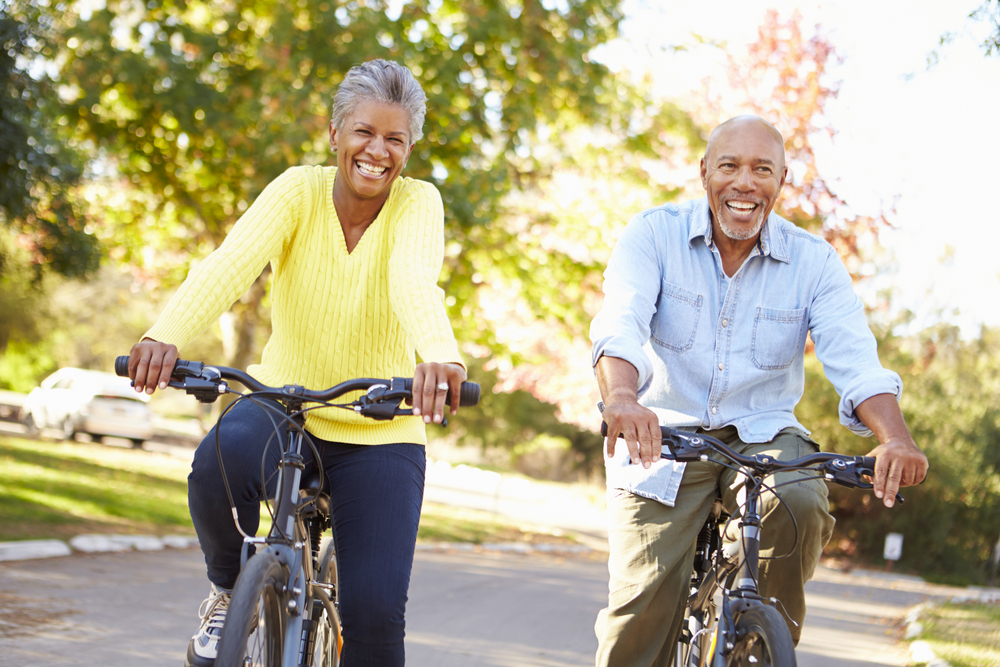1/6/15
With the advent of the New Year, many people start making New Year’s resolutions which often include getting back in shape or losing weight. With that in mind, over the next few weeks we are going to be focusing on exercise and physical activity. Both are helpful in retaining good vision, regardless of your age.

Physical Activity and Exercise
What us the difference between exercise and physical activity? Exercise is generally a planned physical activity that is structured and repetitive such as yoga, Pilates, weight training, tai chi or Zumba classes. Physical activity are things you do throughout the day that involve movement such as gardening, walking the dog, grocery shopping, vacuuming or taking the stairs instead of the elevator. Both provide benefits, and a combination of the two can help improve health and help you lose weight.
Regular exercise and physical activity are important for your physical and mental health, and over long periods of time, can provide you with long-term health benefits. They can also help you reduce the risk of developing some disease and disabilities that can happen as you grow older as well as being an effective treatment for arthritis, heart disease, diabetes and even eye disease.
Exercise and physical activity can benefit you in many ways:
- Help improve your physical strength and fitness
- Help improve your balance
- Help manage and prevent diseases like diabetes, heart disease, osteoporosis, etc.
- Help reduce depression
- Help improve cognitive function
Types of Exercise and Physical Activity
Endurance
This includes activities that increase your breathing and heart rate:
- Brisk walking, hiking or jogging
- Dancing
- Swimming
- Biking or spinning
- Sports such as tennis, squash or basketball
- Yard work such as mowing the grass or raking
- Climbing stairs
Strength
This includes activities that help you in everyday life such as climbing stairs, carrying groceries, etc.:
- Lifting weights
- Resistance training such as using a resistance band or Pilates
Balance
These activities help prevent falls:
- Standing on one foot
- Heel-to-toe walking
- Tai Chi
Flexibility
These activities help you stay flexible and limber, which means more freedom of movement and better posture:
- Shoulder, upper arm and calf stretches
- Yoga
- Pilates
Making Your Goals For Success
Now that you understand the importance of keeping fit, it is time to make a written plan to help you achieve your goals. These goals need to be specific, realistic and important to you to increase your chances for success. They also need to be fun and interesting to keep you engaged. Think about both short-term and long-term (where you want to be in 6 months or a year) goals. Things to consider when making your plans include:
- What kind of activity you want to do
- Why you want to do it
- When you are planning to do it
- Where you will do it
- Any financial considerations such as equipment, shoes and clothing, gym membership, etc.
Writing down your exercise and physical activity goals is important as it will help you follow through with your and help you track your progress. Put them where you can see them, and review them regularly. Some people also find involving another person, such as an exercise buddy or trainer, can help keep them motivated.
It is also wise to consult your doctor about any change in exercise and physical activity. This particularly true if you have had any previous injury, surgery, health issue or are older. While doctors will not tell you to be sedentary, they may have safety tips or suggestions that will help keep you healthy and increase your enjoyment and success with your plan. Things you might want to ask your doctor include:
- Are there any exercises or activities you should avoid
- Let them know about any unexplained symptoms you might have such as chest pain or pressure, joint pain or stiffness, dizziness or shortness of breath
- If you have any ongoing health concerns, how can these affect your exercise of physical activity
- Let them know what your activity plan is and the goals to assure they are reasonable
Finding A Personal Trainer
If you are not used to exercising, are trying a new type of exercise, or need the motivational help, you may want to work with a persona fitness trainer. One of the best ways is to get a referral from someone you know who likes and has had success with their trainer. But it is also important you learn more about the trainer as they will relate to you and your goals. Here are some questions you might want to ask them:
- Do they have a certification from an accredited organization
- How much training experience do they have, including training people your age or medical condition
- Will they be able to develop an exercise program based you your goals and what should you expect from their sessions
- Will the trainer give you a list of references you can check
When making your final assessment consider how well the trainer listened to you and answered your questions. Also, if they have a sense of humor and are a good match to your personality.
These suggestions should get you started for a healthy 2015. Next Tuesday we will explore more ways to help you succeed.
 Susan DeRemer, CFRE
Susan DeRemer, CFRE
Vice President of Development
Discovery Eye Foundation

